German guns of caliber 15, 17 and 21 cm of the First World War
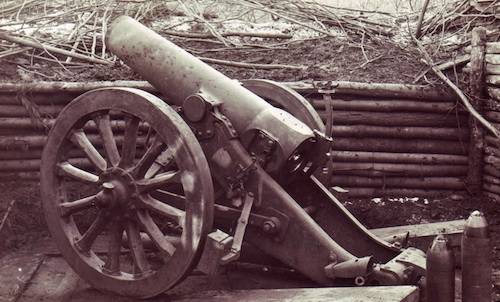
15 cm sFH 93. This is what she looked like in position…
Hit the fountain of fire
And Bob Kennedy started dancing.
What do i care
To all to you?
And you to me!
"The Last Inch" M. Sobol
Heavy guns of the First World War. One of the most massive and popular 152-mm guns during the First World War was the German 15-cm heavy field howitzer mod. 1893. Moreover, her caliber was indeed not 155 mm, like that of the French and Americans, and not 152 mm, but 150 mm (in fact, even a little less!), while the caliber of guns in Germany was traditionally recorded in centimeters. When, at the end of the XNUMXth century, the Germans began to look for a replacement for the guns that had won the Franco-Prussian War, they first of all settled on a gun of this caliber. It turned out that projectiles of similar power, but of a smaller caliber, would be too long, and therefore unstable in flight. The second factor was the development by Krupp of high-strength nickel steel alloys, which made it possible to manufacture gun barrels from much lighter castings. The temptation was great - a light barrel and heavy shells - isn't this the dream of every artilleryman ?!
And so the design of the sFH 93 howitzer, designed to the specifications of the German army and released in 1891, was born. The gun was competitive: Krupp and the firm in Spandau then presented their designs for guns. But it turned out so that no one won an absolute victory. The military took the barrel from Krupp, and the carriage from Spandau - and so, by constructing from ready-made "cubes", the 15-cm heavy field howitzer M1893 was born. The weight in combat position was not so much - 2189 kg, so it could well be transported by servants and six horses towing the howitzer along with the limber.
The appearance of the heavy howitzer in the German field artillery greatly expanded its capabilities. Although it took several years just to develop instructions for its application. But this work was not in vain, and the German heavy howitzers served the German army in good stead in the very first months of the First World War. And although the total number of serial units of sFH 93 is not known, it is believed that about 600 of them were made.
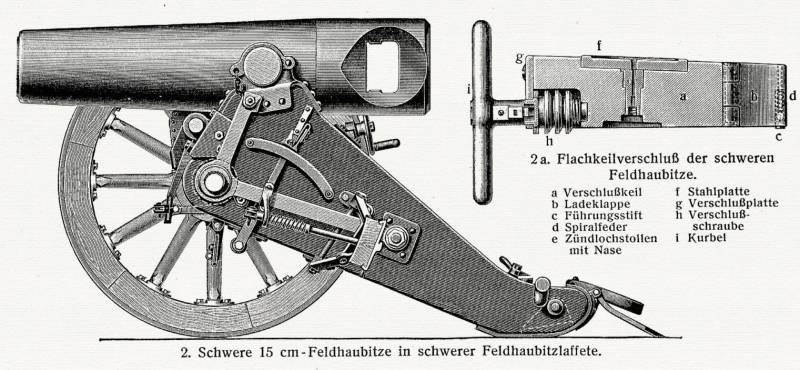
Scheme of the 15-cm sFH 93 gun carriage and a section of its wedge gate
sFH 93 was the most common design for that time. She lacked a recoil brake and a knurler, and the breech was locked with a screw-fed wedge bolt (which slowed down the process of opening it, since it had to be unscrewed from the breech breech) and sealed with a Broadwell copper ring. Loading was separate and capped. Shooting was carried out using a friction tube inserted into a hole in the center of the breech breech. The sFH 93 could fire a variety of rounds, including several types of explosive, incendiary, and smoke rounds.
The howitzer was intended for firing exclusively with mounted fire and had a simple arc sight, similar to the sights of other German guns of that time. The rate of fire was rather low, no more than 2-3 rounds per minute, since the howitzer had to be returned to a horizontal position after each shot, and even rolled back to its original place. For sustained firing, the howitzer was mounted on reed mats with wooden retractable wedges to reduce its tendency to burrow into the ground. The hydraulic recoil brake, clinging to the carriage, was also used in it, but only when firing from stationary platforms.
TTX sFH 93
Caliber: 149,7 mm
Barrel length: 1616 mm (L / 10,8)
Weight in combat position: 2189 kg
Vertical pointing angles: from 0° to +65°
Horizontal pointing angles: 0 °
Initial projectile speed: 280 m / s
Maximum firing range: 6,05 km
Projectile weight: 41 kg
Although the sFH 93 was already obsolete by the beginning of the First World War, it fought through the entire war, although mainly in reserve and training units. Moreover, a significant number of sFH 93 howitzers successfully survived the war and were transferred by Germany to other countries after it ended.
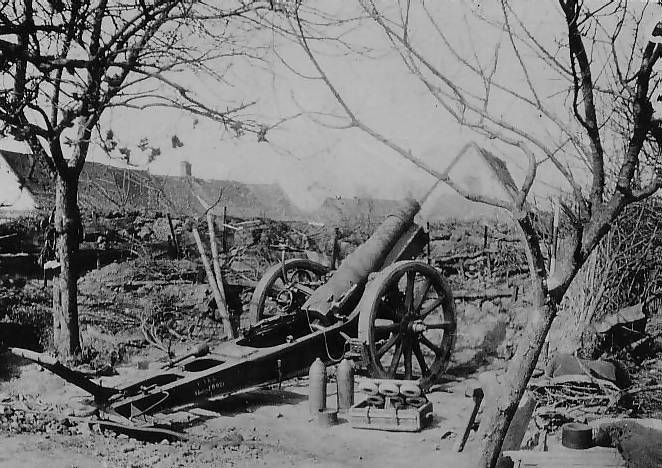
15 cm schweres Feldhaubitze m / 02 (15 cm heavy field howitzer m / 02) - appeared in 1899 and became the first German howitzer with a hydraulic (oil) recoil brake and a spring knurler
So, the Japanese army bought 18 sFH 93 for the war with Russia. All of these howitzers were used during the siege of Port Arthur in 1904. They fired a lightweight 36-kilogram projectile, and it is not known whether the Japanese made them on their own, or ordered Krupp guns along with ammunition from shells lighter than the German ones. The latter, by the way, is quite possible, since it would be quite difficult for undersized Japanese soldiers to lift 45-kilogram shells. And 36-kilogram ones are at least a little easier!
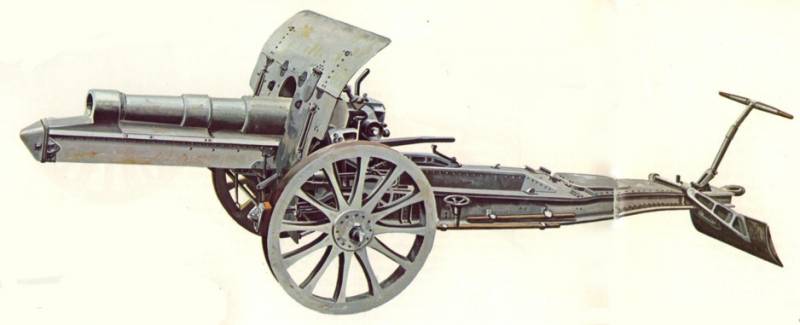
15 cm sFH 02, full name 15 cm schwere Feldhaubitze 1902 (German 15 cm heavy field howitzer 1902) - German heavy howitzer of the First World War, was developed in 1902 and entered service in 1903 ... Fig. http://www.landships
Turkey purchased 36 sFH 93s in 1913 to replace artillery losses suffered in the Balkan War of 1912-1913. How they served and where is unknown.
Like most other countries, Germany entered World War I lacking powerful long-range guns. Therefore, this deficiency had to be filled directly during the war.
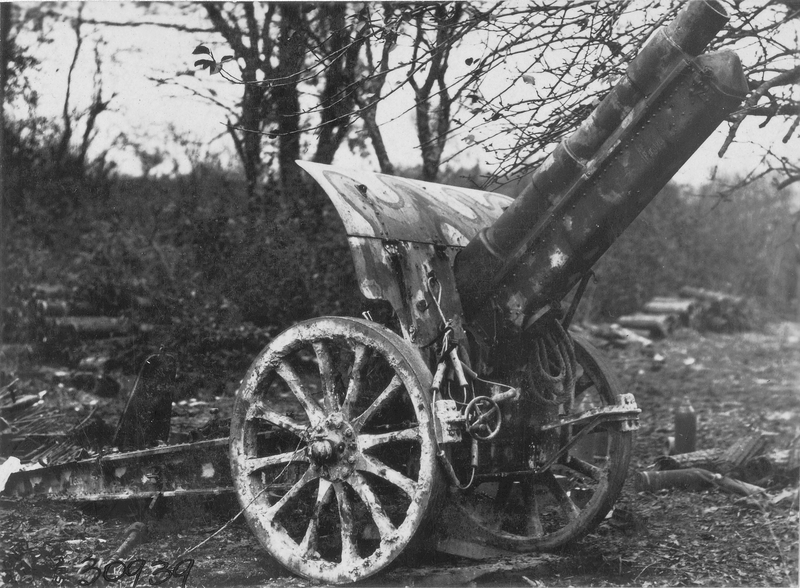
The 15 cm schwere Feldhaubitze 13 (15 cm sFH 13) was a heavy field howitzer used by Germany in World War I and early World War II. Photo taken in the Ardennes
The Krupp firm, always sensitive to the demands of the time, proposed a 15 cm gun already in 1915, which was then adopted under the designation 15 cm gun m16. She was dismantled into two parts, which were towed by vehicles. But since it was constantly lacking, this weapon had to be transported by horses. The length of the barrel in calibers was 42,7, the angle of elevation of the barrel was from -3 ° to + 42 °, and along the horizon the barrel on the wheel axle could move left and right by only 8 °. The weight of the gun was 10 kg. It could fire a 140 kg projectile to a maximum range of 52,5 km. At the same time, the initial velocity of the projectile was 22,8 m / s, which is a very good indicator for today's guns.
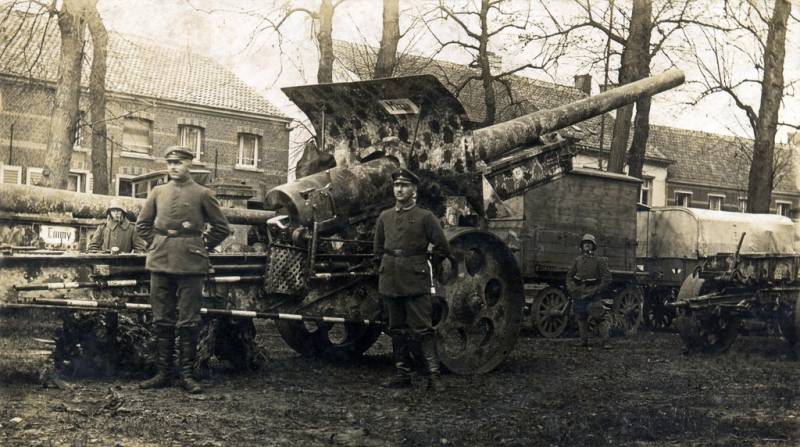
Brave German gunners near their long-range 15 cm Kanone m16
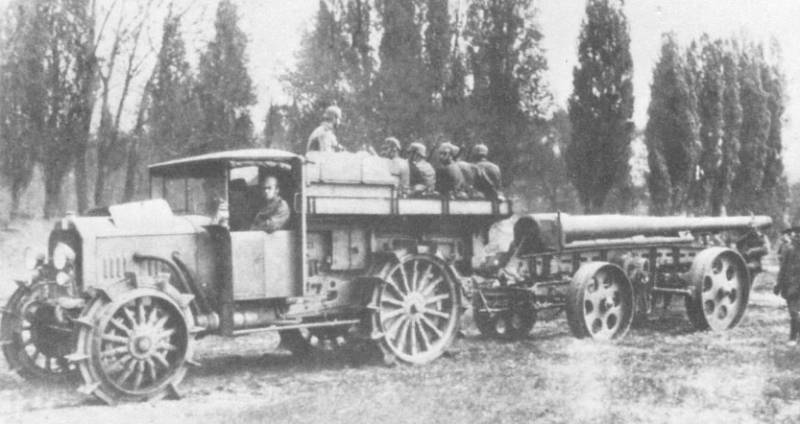
And this is how these guns had to be transported
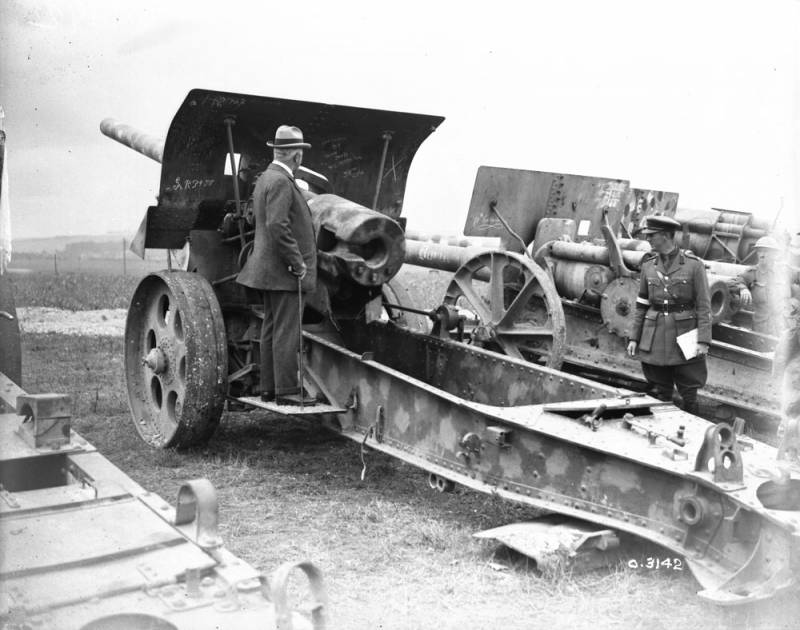
Well, here's how all these "transportations" ended ... Captured German guns, including 15 cm Kanone 16, are examined by Edward Kemp, one of the leaders of the Canadian armed forces in the First World War. August 1918
Soon after the stalemate in the West was established, all the belligerents realized that they badly needed to strengthen their artillery, especially large-caliber guns. In Germany, as in most other countries, naval and coastal defense guns were hastily removed from forts, fortifications and naval depots and mounted on more or less improvised field carriages. In particular, this is how the iR Schnelladekanone 17 cm rapid-fire cannon was born (“iR” is an abbreviation of “in Räderlafette”, that is, “on a wheeled carriage”, and “Schnelladekanone”, which means “quick loader gun”).
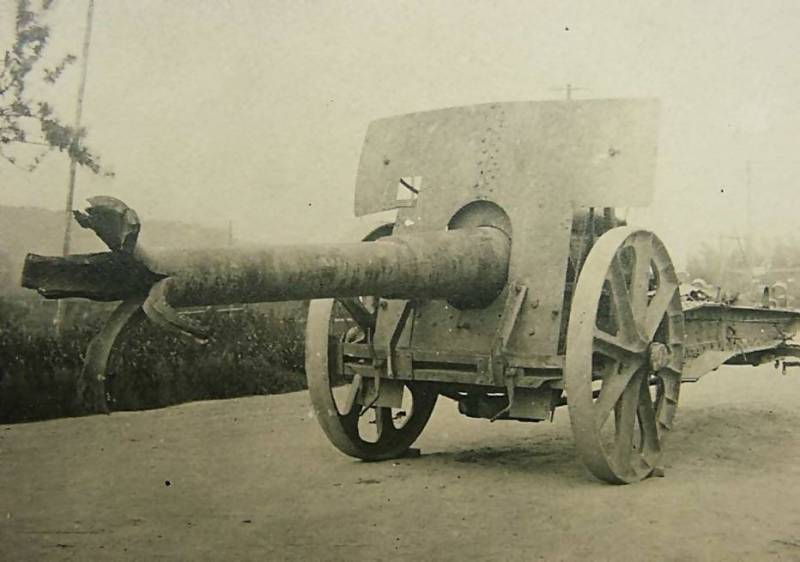
Ek, his barrel was torn apart ... 15 cm L / 40 Feldkanone iR (full name 15 cm Feldkanone L / 40 in Räderlafette) - a 150-mm field gun of the German army during the First World War. Designed as a ship gun, this gun had to be used for the needs of the ground forces
The result was a very effective, but also very bulky, long-range cannon: it weighed at least 23 kg in firing position. For transportation, it was disassembled into three parts, but often turned out to be too heavy both for horses and even for rather weak tractors of that time. Nevertheless, it was a very powerful gun: it could fire a 500 kg projectile to a maximum range of 62,8 km, making it ideal for both harassing fire and counter-battery work. The aiming angle horizontally was equal to 24 °, the elevation angle of the trunk from -8 ° to + 0 °. Barrel length in calibers - L / 45. Krupp began to send it to the army in March 40, and in total about 1917 such guns were made.
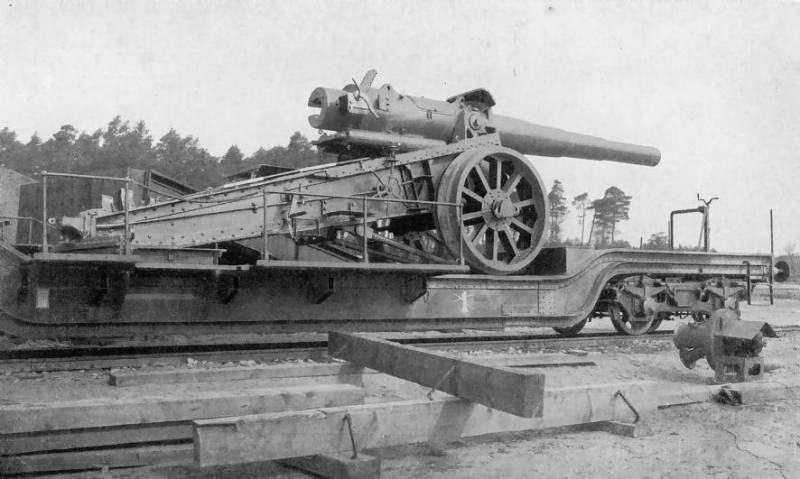
170-mm gun placed on a railway platform for firing
Some of the guns were mounted on railway platforms. These cannons (designated 17-cm Schnelladekanone E, where the "E" stands for "Eisenbahn", i.e. "railway") could fire directly from the wheels, which made them quite maneuverable. In total, 30 17-cm guns were converted into the "E" variant. In the army, these guns were called "Samuel".

17-cm Schnelladekanone E. Fig. A. Sheps
A big disadvantage of naval guns was the short service life on the ground. So, the resource of the barrel of a 17-cm gun was about 100 shots. In principle, this was enough for a battle at sea, but not on land. Therefore, they were "spent" very quickly. So, on October 31, 1918, only about 10 ground and 16 railway guns remained in warehouses and in the troops.
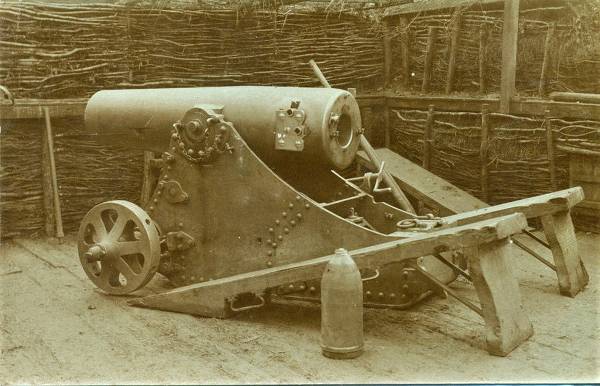
21 cm Morser M99
The German army first used heavy howitzers during the siege of Strasbourg in 1870. The military appreciated the positive effect and in 1883 they ordered another heavy weapon - a 21-cm mortar. But weapon aging quickly, and already in 1899 it was replaced by a new model of the same caliber: 21-cm Morser M99. The mortar was simple, if not primitive. So, to absorb the recoil force, the carriage rolled back when fired on inclined ramps. The wooden wheels in position were changed to much smaller wheels, so that the lower part of the carriage generally rested on the ground.
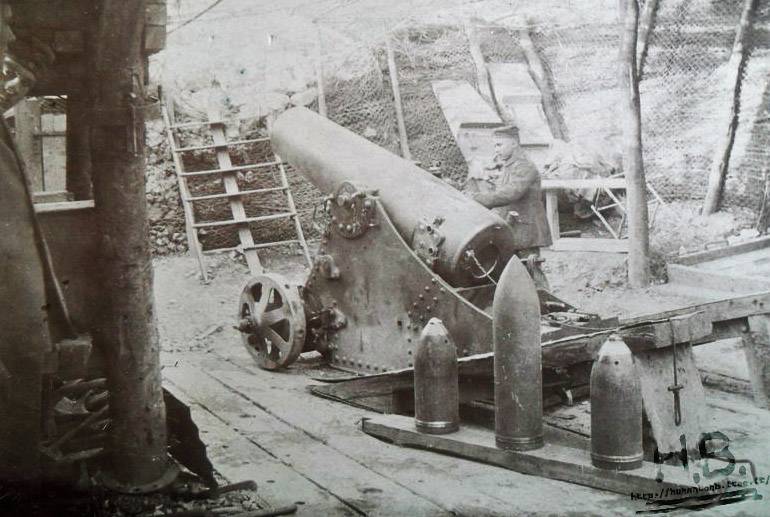
And these are shells of various types for her ...
To the location, the calculation of the mortar moved like a "gypsy camp". A three-ton barrel was carried on a separate wagon, followed by a carriage on its own wooden wheels, and two more recoil ramps, and “fronts” with shells, and charging boxes with powder caps.
The projectile for the mortar weighed 83 kg and flew at 8200 m. Later, a very heavy projectile of 120 kilograms was developed for it, but the maximum firing range was reduced to 7200 meters. Judging by the photographs of that time, the gun crew of 9 people, apparently, was typical for this mortar. To lift the projectile to the breech, it had to be put on a stretcher, which required 4 people to lift.
By the beginning of the First World War, this mortar was also outdated, was in storage and was replaced by the M1910 gun, and then the 21 cm Mrs. (full official name: German langer 21 cm Mörser - “21 cm elongated mortar”, or 21 cm Mrs. 16) - a mortar of the 1916 model of the year, that is, directly from the time of the First World War. In fact, it was a long-barreled modification of the 21 cm Mrs. sample of 1910. But when the first volleys of the war thundered, even 48 old mortars were issued to the artillery units of the Landwehr, and they were in service throughout the war, and the new ones were used as widely as possible throughout the war. So, only at the end of 1916, the German army consisted of 7862 large-caliber guns. The army of the Russian Empire had only 1430. As for the German mortars, it is estimated that by the end of the war they fired about 7 million shots.
TTX mortars 21 cm Morser M99
Caliber: 211 mm
Barrel length in calibers: L/10
Weight in combat position: 4820 kg
Shipping weight: 6380 kg
Vertical pointing angles: +6° to +70°
Horizontal pointing angles: 0 °
Projectile initial velocity: 305 / 308 m / s
Maximum range: 8200 m at a speed of 305 m / s (projectile weighing 83 kg); 7200 m at a speed of 308 m / s (projectile weighing 120 kg)
Projectile weight: 83 and 120 kg
Rate of Fire: 1 shot every 3 minutes
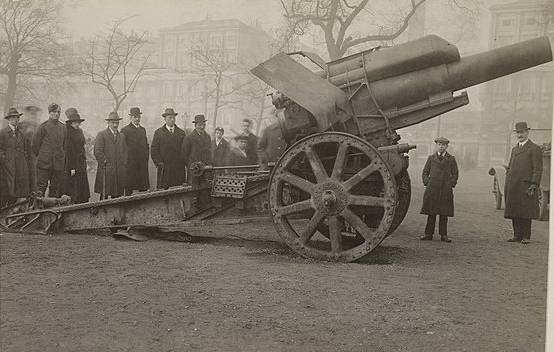
"Elongated Mortar" 21 cm Mrs. 10/16
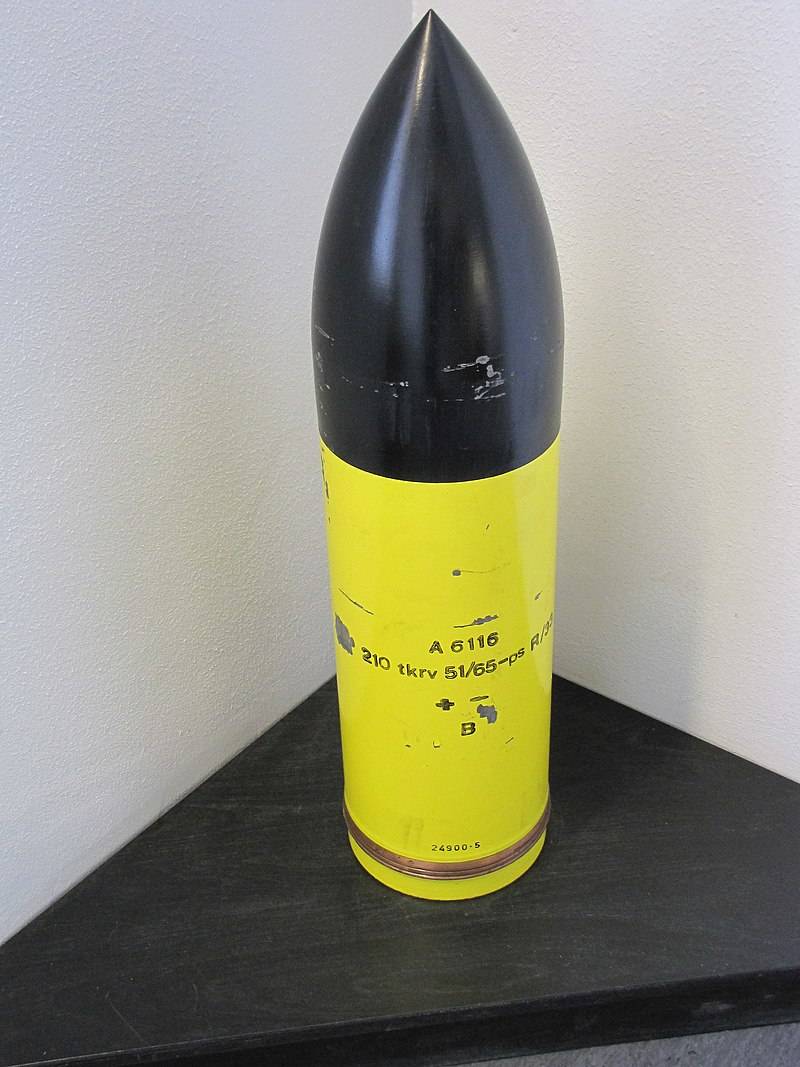
And this is a projectile for her. Private military museum in Hämeenlinna, Finland
That is, the German army did not have anything particularly fantastic in the indicated calibers, but nevertheless it fought and won!
Information